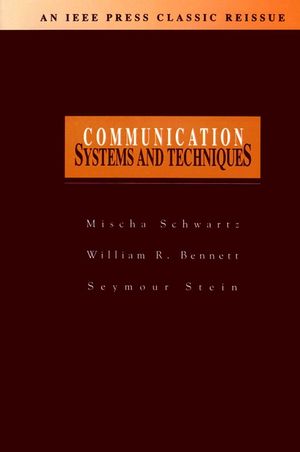Communication Systems and TechniquesISBN: 978-0-7803-4715-1
Paperback
636 pages
November 1995, Wiley-IEEE Press
 This is a Print-on-Demand title. It will be printed specifically to fill your order. Please allow an additional 10-15 days delivery time. The book is not returnable.
|
||||||
Preface.
PART I Mischa Schwartz.
Chapter 1. GENERAL TUTORIAL MATERIAL.
1-1. Summary of Statistical Properties of Noise.
1-2. Orthogonal Series Representations of Noise.
1-3. A Simple Application to Binary Transmission.
1-4. Narrowband Noise and Envelope Detection.
1-5. Application to Binary Transmission.
1-6. Hilbert-transform Representation of Signals.
1-7. Preenvelope and Envelope of Signals; Application to Noise.
1-8. Low-pass Equivalents of Bandpass Signals.
Chapter 2. STATISttCAL COMMUNICATION THEORY AS APPLIED TO DIGITAt COMMUNICATIONS.
2-1. Statistical Decision Theory.
2-2. Decision Theory in the Case of Binary-signal Repetition.
2-3. Neyman-Pearson Theory of Testing Hypotheses with Application to Radar.
2-4. Signal Shape and Matched Filters.
2-5. Transmission of Two Known Messages of Arbitrary Shape.
2-6. Sampling of Band-limited Signals.
2-7. Decision-theory Approach to Af-ary Signal Transmission.
Chapter 3. CW COMMUNICATIONS: COMPARISON OF AM AND FM.
3-1. S/N ratios in AM.
3-2. Spectral Analysis of Envelope Detectors.
3-3. Correlation-function Method of Determining Power Spectrum.
3-4. Frequency-modulation Noise Analysis.
3-5. FM Noise Output, Carrier Absent.
3-6. Second Threshold in FM: Decrease in Output Signal.
3-7. Zero-crossing Analysis.
3-8. A Heuristic Approach to FM Threshold Analysis—Rice's "Clicks" Analysis.
3-9. Threshold Extension in FM: FMFB Demodulators and Phase-locked Loops.
3-10. FM Spectrum Analysis, Noiselike Modulating Signal.
PART II William R. Bennett.
Chapter 4. AMPLITUDE MODULATION AND RELATED CW SYSTEMS.
4-1. Structure of an AM Wave.
4-2. Amplitude Modulators.
4-3. Amplitude Detectors.
4-4. Systems Derived from AM.
4-5. Analysis of Modulating and Demodulating Circuits.
4-6. Effect of Distortion in Transmitting Medium.
4-7. Multiplexing of AM Channels.
Chapter 6. ANGLE MODULATION IN CW SYSTEMS.
5-1. Phase Modulation.
5-2. Frequency Modulation.
5-3. Spectral Resolution for Sinusoidal Angle Modulation.
5-4. Transmission through Linear Networks.
5-5. The FM Interference Problem.
5-6. Compound CW Modulation Systems.
Chapter 6. PULSE MODULATION.
6-1. Pulse Amplitude Modulation (PAM).
6-2. Pulse Time Modulation.
6-3. Pulse Code Modulation (PCM).
6-4. Compound Pulse-modulation Systems.
PART III Seymour Stein.
Chapter 7. BASIC BINARY COMMUNICATIONS TECHNIQUES.
7-1. Carrier Telegraphy.
7-2. Relation of Character or Code Performance to Binary Error Rate.
7-3. Representations of Bandpass Signals, Noise, and Filtering.
7-4. On-off Keying.
7-5. Frequency-shift Keying (FSK).
7-6. Phase-shift Keying (PSK).
7-7. Suboptimum versus Matched Filters.
Chapter 8. GENERAL ANALYSIS OF SINGLE-CHANNEL BINARY SYSTEMS IN ADDITIVE NOISE.
8-1. Generalized Models.
8-2. A Unified Formulation and Its Solution.
8-3. Specializations, Including Previous Results.
8-4. Distribution of Instantaneous Frequency For Signal Plus Noise.
8-5. Binary FSK with Frequency Detection.
Chapter 9. FADING COMMUNICATION MEDIA.
9-1. Role of Fading Channels within the Radio Spectrum.
9-2. Phenomenological Descriptions of Multipath and Fading.
9-3. High-frequency Ionospheric-skywave Propagation.
9-4. Tropospheric-scatter Propagation.
9-5. Single Binary Channels in Slow, Nonselective Rayleigh Fading.
9-6. Signal Behavior in Channels with Arbitrary Selectivity and Rapidity.
Chapter 10. LINE ARDIVERSITY COMBINING TECHNIQUES.
10-1. Methods for Achieving Diversity Branches.
10-2. General Principles of Linear Combining.
10-3. Diversity Improvement and Relation to System Design.
10-4. Selection Combining.
10-5. Maximal-ratio Combining.
10-6. Equal-gain Combining.
10-7. Further Comments on Comparative Combiner Statistics.
10-8. Digital Data Performance of Ideal Linear Combining Systems.
10-9. Postdetection versus Predetection Combining in FM Systems; Digital Data Transmission in FDM-FM.
10-10. Effect of Correlation in Fading among Diversity Branches.
10-11. Effect of Diversity on Distributions of Lengths of Fades.
10-12. Effect of External Noise or Interference.
Chapter 11. DECISION-ORIENTED DIVERSITY FOR DIGITAL TRANSMISSION.
11-1. Optimum Combining for Digital Signaling in Slow, Nonselective Fading.
11-2. Performance of Quadratic Combiner Systems in Slow, Multiplicative Fading.
11-3. Performance of Suboptimal Systems.
11-4. Diversity Operation Involving Energy Sharing and Energy Detection.
11-5. Wideband Antimultipath Systems (Rake).
APPENDIX A. The Q Function and Related Integrals.
APPENDIX B. Distribution of Hermitian Quadratic Form in Complex Gaussian Variates.
Bibliography.
Index.



